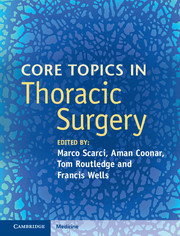Book contents
- Frontmatter
- Contents
- List of contributors
- Section I Diagnostic work-up of the thoracic surgery patient
- Section II Upper airway
- Section III Benign conditions of the lung
- Section IV Malignant conditions of the lung
- 11 Evaluation of solitary pulmonary nodule
- 12 Lung cancer staging
- 13 Pathological considerations in lung malignancy
- 14 Medical treatment of lung cancer (neo and adjuvant chemoradiotherapy)
- 15 Superior vena cava obstruction: etiology, clinical presentation and principles of treatment
- 16 Robotics in thoracic surgery
- 17 Pulmonary metastasectomy
- Section V Diseases of the pleura
- Section VI Diseases of the chest wall and diaphragm
- Section VII Disorders of the esophagus
- Section VIII Other topics
- Index
- References
16 - Robotics in thoracic surgery
from Section IV - Malignant conditions of the lung
Published online by Cambridge University Press: 05 September 2016
- Frontmatter
- Contents
- List of contributors
- Section I Diagnostic work-up of the thoracic surgery patient
- Section II Upper airway
- Section III Benign conditions of the lung
- Section IV Malignant conditions of the lung
- 11 Evaluation of solitary pulmonary nodule
- 12 Lung cancer staging
- 13 Pathological considerations in lung malignancy
- 14 Medical treatment of lung cancer (neo and adjuvant chemoradiotherapy)
- 15 Superior vena cava obstruction: etiology, clinical presentation and principles of treatment
- 16 Robotics in thoracic surgery
- 17 Pulmonary metastasectomy
- Section V Diseases of the pleura
- Section VI Diseases of the chest wall and diaphragm
- Section VII Disorders of the esophagus
- Section VIII Other topics
- Index
- References
Summary
Life is pretty simple: You do some stuff. Most fails. Some works. You do more of what works. If it works big, others quickly copy it. Then you do something else. The trick is the doing something else.
– Leonardo da VinciIntroduction
Minimally invasive thoracic surgery has been a hot topic in the past decades. With the development of robotic surgery, thoracic surgeons entered a newer and more exciting field. Much progress in minimally invasive surgery has been made, and robotic surgery is accepted as a potential diagnostic and treatment modality for thoracic diseases. In this chapter, we provide a comprehensive review of the history and the current data in robotic thoracic surgery.
History of minimally invasive thoracic surgery
The first thoracoscopic procedure was described 100 years ago. In 1910, Jacobeaus examined the pleural cavity with a cytoscope and was the first to perform a thoracoscopic procedure. In the late 1980s, minimally invasive surgical techniques were developed, and after the success of laparoscopic surgery, video-assisted thoracic surgery (VATS) was established in the 1990s.
The first prospective randomized studies did not meet the high expectations and showed no significant benefit for the VATS approach compared with thoracotomy. More recent studies, however, show advantages such as reduced blood loss, less pain, lower inflammatory responses and an earlier return to work. Today, VATS plays a role in the diagnostic and therapeutic procedures for benign and malignant tumours arising from the lung or adjacent organs. Although these studies show favourable results, there are still important limitations. The lack of three-dimensional vision, loss of wrist articulation and natural hand-eye coordination can reduce surgical precision.
Robotic surgical systems in the medical industry were developed to overcome these limitations. The first robotic system used for surgical procedures was the Puma 560. Kwoh et al. used the robot in 1985 to perform neurosurgical biopsies, and in 1988, Davies et al. performed a transurethral prostatectomy with the Puma 560. Robotic systems developed later, originated from telepresence machines that were developed for NASA.
The rationale of developing a robotic system was to use it in the US Army in war areas by ‘bringing the surgeon to the wounded soldier through telepresence’.
- Type
- Chapter
- Information
- Core Topics in Thoracic Surgery , pp. 158 - 166Publisher: Cambridge University PressPrint publication year: 2016

